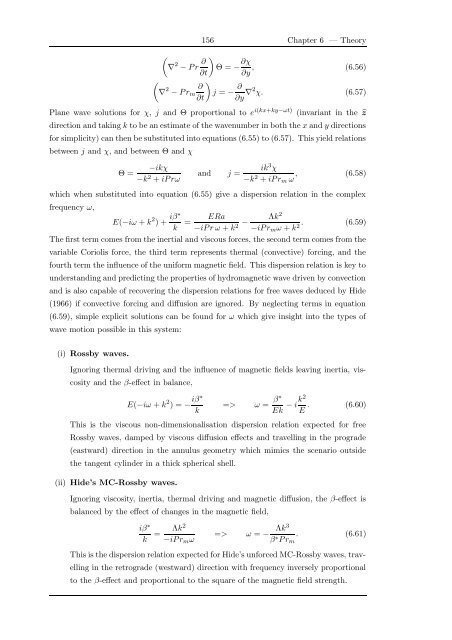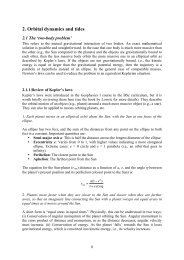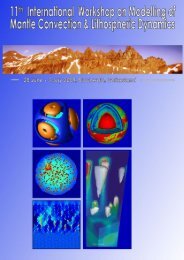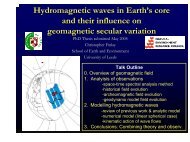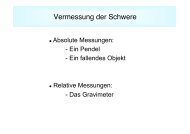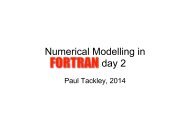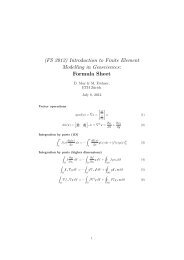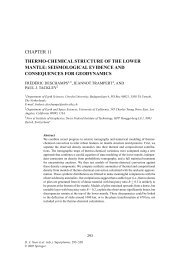Hydromagnetic waves in Earth's core and their influence on ...
Hydromagnetic waves in Earth's core and their influence on ...
Hydromagnetic waves in Earth's core and their influence on ...
Create successful ePaper yourself
Turn your PDF publications into a flip-book with our unique Google optimized e-Paper software.
156 Chapter 6 — Theory(∇ 2 − P r ∂ )Θ = − ∂χ∂t ∂y , (6.56)()∇ 2 ∂− P r m j = − ∂∂t ∂y ∇2 χ. (6.57)Plane wave soluti<strong>on</strong>s for χ, j <str<strong>on</strong>g>and</str<strong>on</strong>g> Θ proporti<strong>on</strong>al to e i(kx+ky−ωt) (<str<strong>on</strong>g>in</str<strong>on</strong>g>variant <str<strong>on</strong>g>in</str<strong>on</strong>g> the ẑdirecti<strong>on</strong> <str<strong>on</strong>g>and</str<strong>on</strong>g> tak<str<strong>on</strong>g>in</str<strong>on</strong>g>g k to be an estimate of the wavenumber <str<strong>on</strong>g>in</str<strong>on</strong>g> both the x <str<strong>on</strong>g>and</str<strong>on</strong>g> y directi<strong>on</strong>sfor simplicity) can then be substituted <str<strong>on</strong>g>in</str<strong>on</strong>g>to equati<strong>on</strong>s (6.55) to (6.57). This yield relati<strong>on</strong>sbetween j <str<strong>on</strong>g>and</str<strong>on</strong>g> χ, <str<strong>on</strong>g>and</str<strong>on</strong>g> between Θ <str<strong>on</strong>g>and</str<strong>on</strong>g> χΘ =−ikχ−k 2 + iP rω<str<strong>on</strong>g>and</str<strong>on</strong>g> j =ik 3 χ−k 2 + iP r m ω , (6.58)which when substituted <str<strong>on</strong>g>in</str<strong>on</strong>g>to equati<strong>on</strong> (6.55) give a dispersi<strong>on</strong> relati<strong>on</strong> <str<strong>on</strong>g>in</str<strong>on</strong>g> the complexfrequency ω,E(−iω + k 2 ) + iβ∗k = ERa−iP r ω + k 2 − Λk 2−iP r m ω + k 2 . (6.59)The first term comes from the <str<strong>on</strong>g>in</str<strong>on</strong>g>ertial <str<strong>on</strong>g>and</str<strong>on</strong>g> viscous forces, the sec<strong>on</strong>d term comes from thevariable Coriolis force, the third term represents thermal (c<strong>on</strong>vective) forc<str<strong>on</strong>g>in</str<strong>on</strong>g>g, <str<strong>on</strong>g>and</str<strong>on</strong>g> thefourth term the <str<strong>on</strong>g>in</str<strong>on</strong>g>fluence of the uniform magnetic field. This dispersi<strong>on</strong> relati<strong>on</strong> is key tounderst<str<strong>on</strong>g>and</str<strong>on</strong>g><str<strong>on</strong>g>in</str<strong>on</strong>g>g <str<strong>on</strong>g>and</str<strong>on</strong>g> predict<str<strong>on</strong>g>in</str<strong>on</strong>g>g the properties of hydromagnetic wave driven by c<strong>on</strong>vecti<strong>on</strong><str<strong>on</strong>g>and</str<strong>on</strong>g> is also capable of recover<str<strong>on</strong>g>in</str<strong>on</strong>g>g the dispersi<strong>on</strong> relati<strong>on</strong>s for free <str<strong>on</strong>g>waves</str<strong>on</strong>g> deduced by Hide(1966) if c<strong>on</strong>vective forc<str<strong>on</strong>g>in</str<strong>on</strong>g>g <str<strong>on</strong>g>and</str<strong>on</strong>g> diffusi<strong>on</strong> are ignored. By neglect<str<strong>on</strong>g>in</str<strong>on</strong>g>g terms <str<strong>on</strong>g>in</str<strong>on</strong>g> equati<strong>on</strong>(6.59), simple explicit soluti<strong>on</strong>s can be found for ω which give <str<strong>on</strong>g>in</str<strong>on</strong>g>sight <str<strong>on</strong>g>in</str<strong>on</strong>g>to the types ofwave moti<strong>on</strong> possible <str<strong>on</strong>g>in</str<strong>on</strong>g> this system:(i) Rossby <str<strong>on</strong>g>waves</str<strong>on</strong>g>.Ignor<str<strong>on</strong>g>in</str<strong>on</strong>g>g thermal driv<str<strong>on</strong>g>in</str<strong>on</strong>g>g <str<strong>on</strong>g>and</str<strong>on</strong>g> the <str<strong>on</strong>g>in</str<strong>on</strong>g>fluence of magnetic fields leav<str<strong>on</strong>g>in</str<strong>on</strong>g>g <str<strong>on</strong>g>in</str<strong>on</strong>g>ertia, viscosity<str<strong>on</strong>g>and</str<strong>on</strong>g> the β-effect <str<strong>on</strong>g>in</str<strong>on</strong>g> balance,E(−iω + k 2 ) = − iβ∗k=> ω = β∗Ek − ik2 E . (6.60)This is the viscous n<strong>on</strong>-dimensi<strong>on</strong>alisati<strong>on</strong> dispersi<strong>on</strong> relati<strong>on</strong> expected for freeRossby <str<strong>on</strong>g>waves</str<strong>on</strong>g>, damped by viscous diffusi<strong>on</strong> effects <str<strong>on</strong>g>and</str<strong>on</strong>g> travell<str<strong>on</strong>g>in</str<strong>on</strong>g>g <str<strong>on</strong>g>in</str<strong>on</strong>g> the prograde(eastward) directi<strong>on</strong> <str<strong>on</strong>g>in</str<strong>on</strong>g> the annulus geometry which mimics the scenario outsidethe tangent cyl<str<strong>on</strong>g>in</str<strong>on</strong>g>der <str<strong>on</strong>g>in</str<strong>on</strong>g> a thick spherical shell.(ii) Hide’s MC-Rossby <str<strong>on</strong>g>waves</str<strong>on</strong>g>.Ignor<str<strong>on</strong>g>in</str<strong>on</strong>g>g viscosity, <str<strong>on</strong>g>in</str<strong>on</strong>g>ertia, thermal driv<str<strong>on</strong>g>in</str<strong>on</strong>g>g <str<strong>on</strong>g>and</str<strong>on</strong>g> magnetic diffusi<strong>on</strong>, the β-effect isbalanced by the effect of changes <str<strong>on</strong>g>in</str<strong>on</strong>g> the magnetic field,iβ ∗k = Λk2−iP r m ω=> ω = − Λk3β ∗ P r m. (6.61)This is the dispersi<strong>on</strong> relati<strong>on</strong> expected for Hide’s unforced MC-Rossby <str<strong>on</strong>g>waves</str<strong>on</strong>g>, travell<str<strong>on</strong>g>in</str<strong>on</strong>g>g<str<strong>on</strong>g>in</str<strong>on</strong>g> the retrograde (westward) directi<strong>on</strong> with frequency <str<strong>on</strong>g>in</str<strong>on</strong>g>versely proporti<strong>on</strong>alto the β-effect <str<strong>on</strong>g>and</str<strong>on</strong>g> proporti<strong>on</strong>al to the square of the magnetic field strength.


